Most people are surprised when they hear that I have no education in photography. I went to college for music and then somehow ended up here. In the modern age of digital cameras, you learn by shooting. Take some pictures, look at them, repeat. There’s also plenty of reading to do on the net and in books, but experimentation (just a fancy word for messing around) is the key.
Personally I get fascinated by other people’s pictures. I don’t actually spend too much time looking at other people’s work, mostly because it makes me frustrated and cranky. But often I get this urge to figure out how they did it. For me, this is the best way to learn about light. Find photographers you admire and try to emulate their work. Not so that you can mimic them perfectly, but so you can take their tricks and add them to your arsenal and make them your own. As the famous quote from Picasso said, “Bad artists copy. Great artists steal.”
This might be a good time to mention that while in this essay I’m talking about other photographers, it’s also a time honored tradition to steal from painters as well. The only problem I’ve found with this is that painters often take liberties with the direction, quality, and quantity of light. They’re using their eyes and imaginations to see, you’ve got to use a camera which isn’t quite as good at it. Ok, back to the show already in progress.
There are two big giveaways for light. Eyes and shadows. If you can see the eyes of the subject, often you can tell exactly what kind of light setup the photographer was using. Pick up one of the magazines when you’re in line at the grocery store and get real close and look at the covergirl’s eyes. Most of the time you can see a light or two or three in the reflection. And moreover, you can see the relative size of them and often you get enough information to tell exactly what they used. Ribs on an umbrella, or tell-tale signature of a ringlight; which brings me to shadows. Always look at the shadows in an image because they can tell you the direction that the light came from and whether the source was hard or soft.
Put this all together with some experimenting and a good friend who is willing to sit and be shot while you kerfutz stuff and you’ll be learning right and left in no time flat.
I do all of this all the time, ask anyone who ever spends any time with me, and you can see the results in my work. The object here isn’t to do exactly what they do, but rather figure out HOW they do what they do so you know how to get that look when you want it. Here are a few examples to get you going…
Harder spot with ringlight fill like Dan Winters:

One big light and simple background à la Greenfield-Sanders:

Two light pin-up like Seliger did for the Vanity Fair series:

You get the point…
